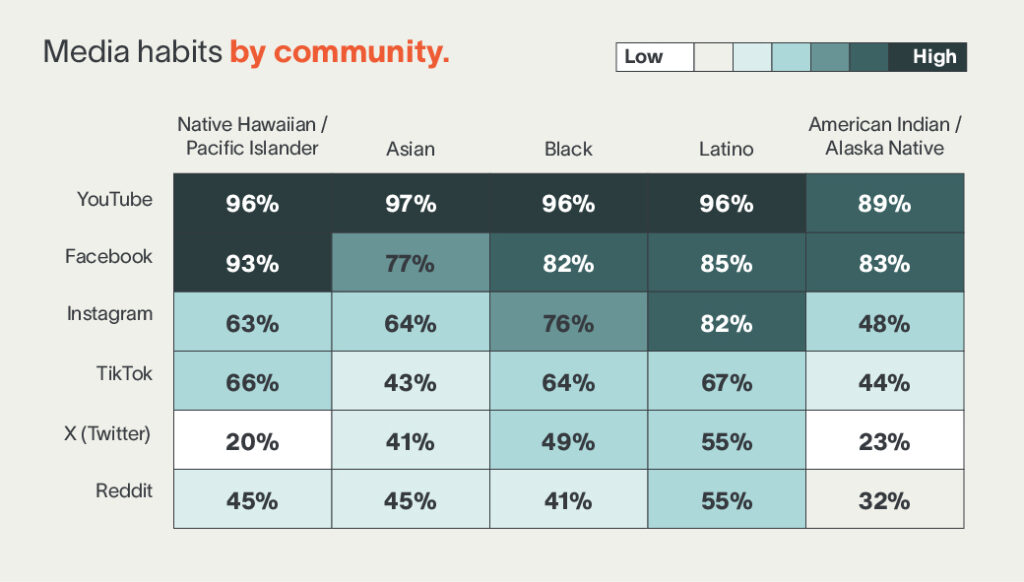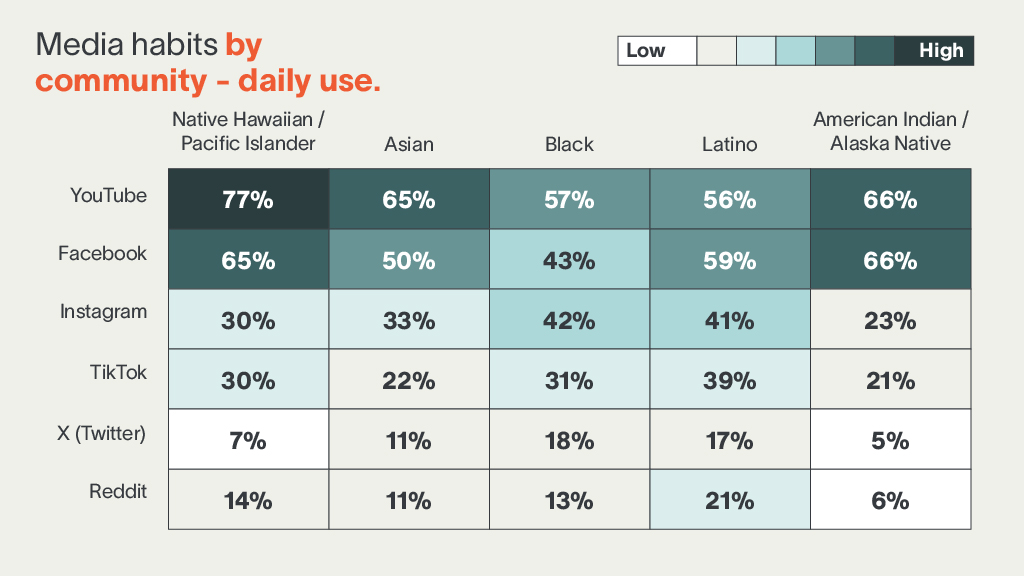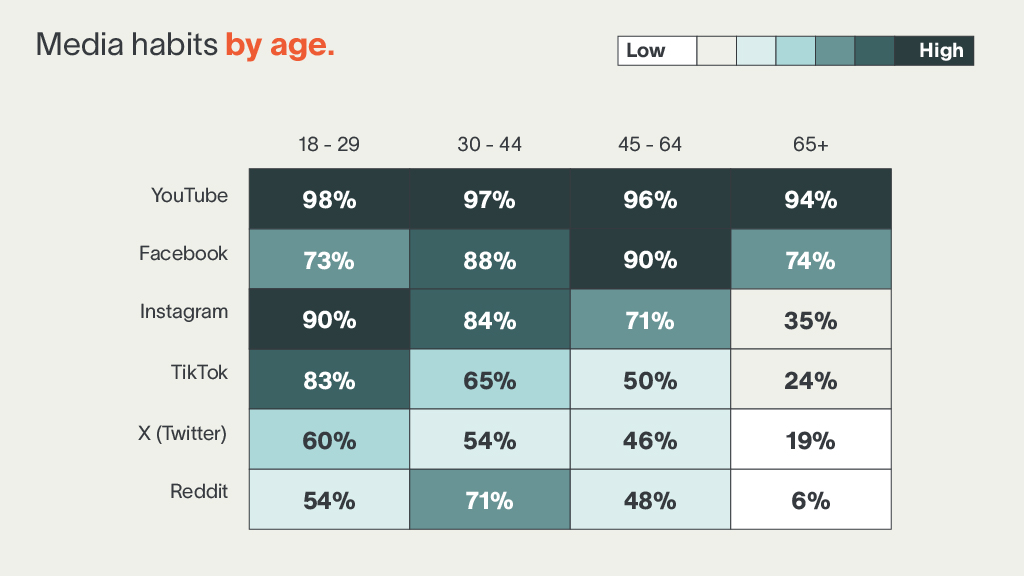Organizations across the Puget Sound are continuously working to reach diverse communities who call our region home. It’s critical to first understand these communities’ unique values, experiences, and perceptions to ensure culturally resonant communication. Our research found that only 58% of communities of color feel represented in advertisements and marketing materials – which means there is a significant gap that we must continue to address.
DHM Research and Quinn Thomas launched an in-depth study with several communities of color in Washington state including: Asian, American Indian/Alaska Native, Black, Latino, and Native Hawaiian/Pacific Islander residents to ask how they identify themselves, and distinctions in news and online habits to help us better understand how to reach audiences where they are.
We centered the needs of these communities throughout our research approach by 1) working with our partners at Creativo Consulting to transcreate the survey into four additional languages – Spanish, Vietnamese, Traditional and Simplified Chinese and 2) engaging community-based organizations who work with communities of color across the region to ensure their perspectives were incorporated into our approach and how we are interpreting these findings.
As expected, communities of color are not a monolith. There are key distinctions we must keep in mind as communicators to ensure resonance in our outreach strategies.
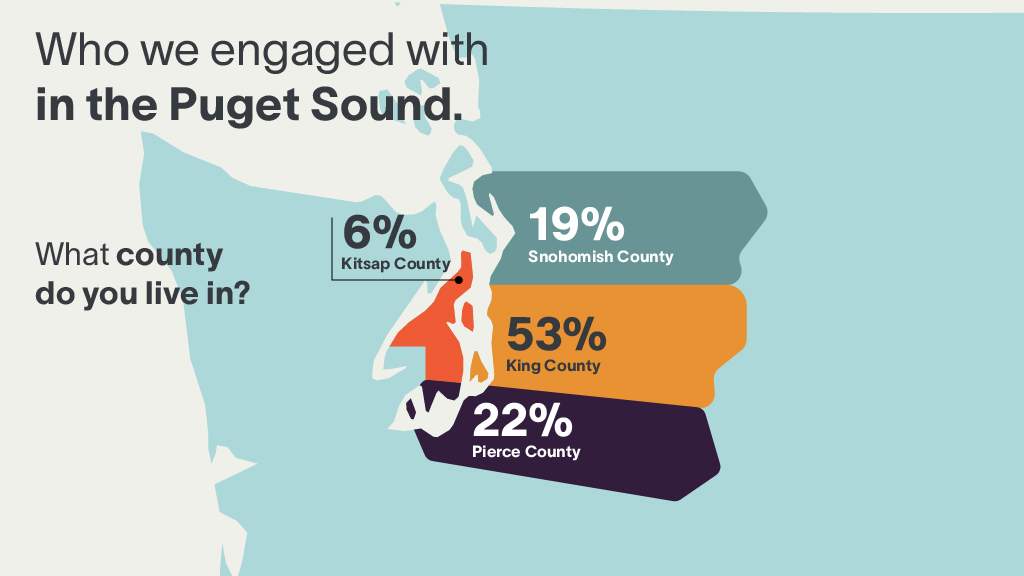
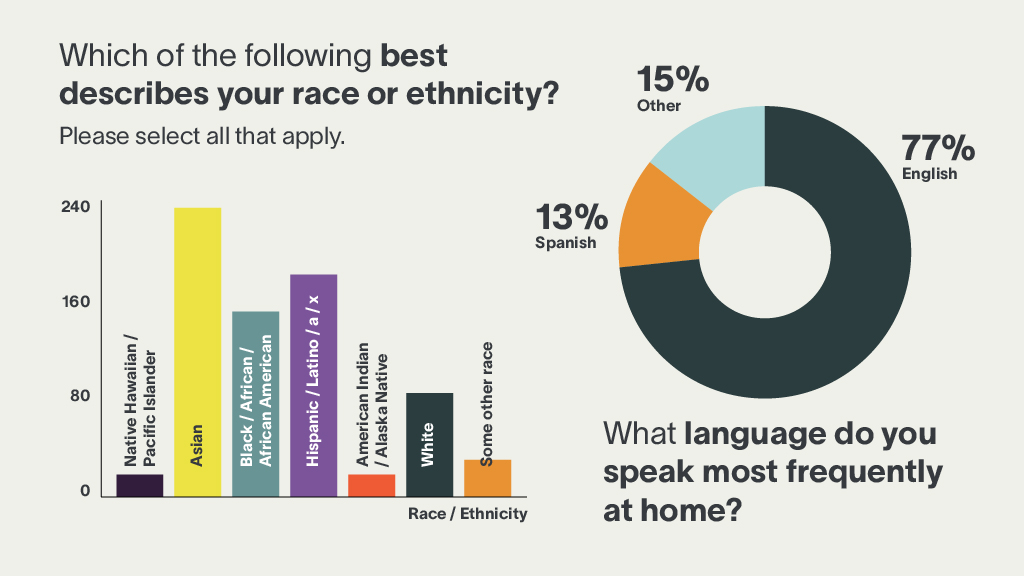
Grounding in the PNW
Our Insights research is an opportunity to explore the unique dynamics of our region and those who live here. One trend that can’t be overlooked is how the population in the Puget Sound is shifting and gradually becoming more racially diverse, largely due to increases in Asian and Hispanic populations.
One key finding of our research is differing perceptions of the direction of Washington state. Within communities of color, 51% of respondents believe our state is going in the right direction, compared to just 39% of the general public in the Puget Sound. Respondents share the same key concerns as the general population – homelessness/poverty, crime/public safety, and cost of living –yet seem to have a higher degree of optimism despite these challenges.
While there’s not a clear indication as to why this may be, conversations with Creativo Consulting illuminated a few potential contributing factors. They shared that immigrants who experienced strife or other challenges in their home country may view Washington or the U.S. more favorably in comparison. However, this is a sentiment that could erode over time, as these individuals assimilate into U.S. culture.
While our research does not focus on immigrants specifically (who comprised 7% of our respondents), it’s an interesting sentiment we may seek to explore in a future research project. Our transcreation partners emphasized that many of the respondents we surveyed are part of cultures that tend to be more collective, compared to the individualistic tendencies more commonly held in the U.S., which could also impact someone’s perceptions of community progress.
Our research also found that respondents enjoy living in the Pacific Northwest – and that living in this region is part of their identity. 77% of all respondents said where they live is important to who they are – which also trends higher than what we have seen in some general population research. Respondents selected nature and environmental protections as the top reason they value living in the Puget Sound.
In a media landscape where newsrooms are shrinking and there’s an ongoing shift toward digital-only content, local broadcast continues to be a highly trusted source for news for communities of color in the region. Respondents were more likely to select local news as a top source of trustworthy news and information (34%) than national news (27%). This trends even higher for Native Hawaiian/Pacific Islanders and (45%) and Asian audiences (49%), as well as seniors across all cultures – 51% of those 65+ said they rely on local TV as their top source for news and information.
Communicators have a huge opportunity to reflect the contributions of communities of color to our region, and tie into their sense of community and love of nature. In selecting campaign channels and trusted messengers, there is value in an integrated approach and thoughtful leveraging of earned media coverage to tap into well-established trust.
Exploring Personal Identity in Communities of Color
To effectively reach key audiences, it’s critical to understand how they think about themselves and their values. We asked Asian, American Indian/Alaska Native, Black, Latino, and Native Hawaiian/Pacific Islanders how they identified themselves, and what types of factors are most important to them in terms of self-identity.
Role in their family was overall the most important personal characteristic for communities of color. Four out of five respondents said it is important, with more than half indicating it is very important. This overall trends higher than general population data we see in Washington. The importance of family role also increases with age. Respondents 65 and up were the most likely to select this as their top identifier – over twice as likely as our 18-29 respondents.
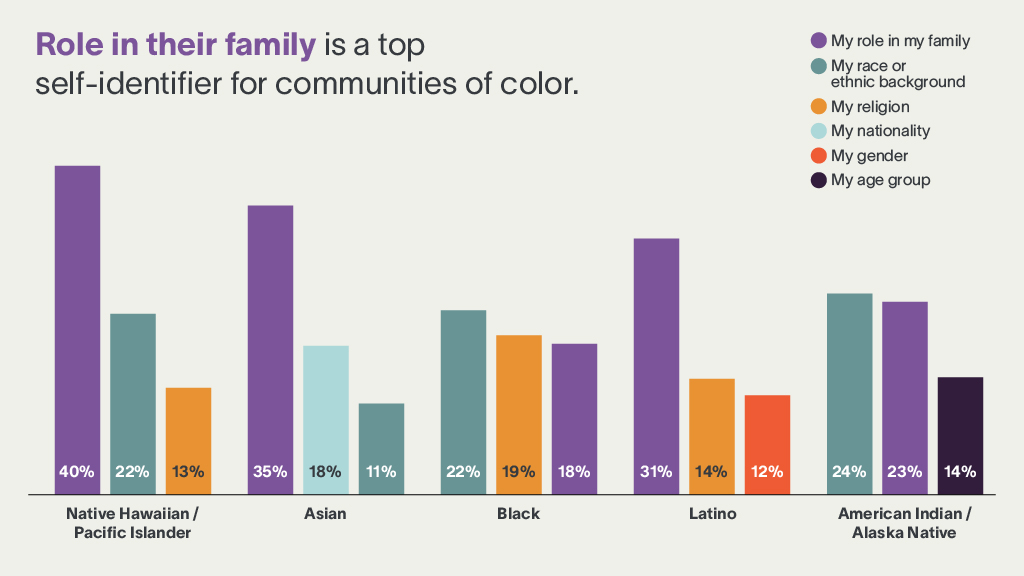
In terms of other top self-identifiers, 42% of audiences included race or ethnic background as a top three identifier, which also trends higher than general population data. By comparison, factors such as religion, occupation, and political party were not highly ranked in terms of importance on identity.
Tying into values of family and culture, while reflecting the race and ethnicity of your audience, can ensure communications are more authentic and resonant, and therefore more likely to drive engagement.
Communities of Color in the Puget Sound Generally Do Not Identify with the Term BIPOC
Vocabulary is a vital tool in a communicator’s toolkit, requiring continuous sharpening, especially when describing diverse ethnic communities.
We asked our respondents about the terms they identify with most closely and found that only 22% of respondents would describe themselves as a “Person of Color” and only 3% would describe themselves as “BIPOC” – Black, Indigenous, Person of Color.
When we explored this with our community-based partners, we heard from Dr. Lillian Robertson, executive director of Marvin Williams Recreation Center, about why there may be hesitation to use a term like BIPOC.
“From my experience, the term BIPOC tends to make Black and African American people feel it dilutes their culture and identity when grouped with other communities of color rather than being identified as a standalone community,” said Dr. Robertson. The consequence of this grouping can also be that the unique challenges each individual community faces may be erased or minimized. This can be a contrast from organizations who are using the term BIPOC with the intention of highlighting Black and Indigenous populations, and may indicate the need to revisit word choice more regularly.
Age is also a factor. 34% of 18-29 year olds, our youngest respondents, describe themselves as People of Color, which was significantly higher than other age groups.
We also validated that Native Hawaiian and Pacific Islanders generally do not identify as Asian (only 16% said they do). While the basis for this would need to be explored through further research, anecdotally, we’ve heard that this may be due to the vast geographic distance of Hawaii and other Pacific Islands from the continent of Asia, and a sense of distinctly separate cultures.
Additionally, we explored terminology and identity in the Hispanic and Latin American communities. 85% of people who identify as Hispanic or Latino/a/x in the Puget Sound have heard of the term “Latinx,” but only 33% use the term to describe themselves. Similar to the usage of “BIPOC,” awareness and usage of the term “Latinx” was higher in younger respondents.
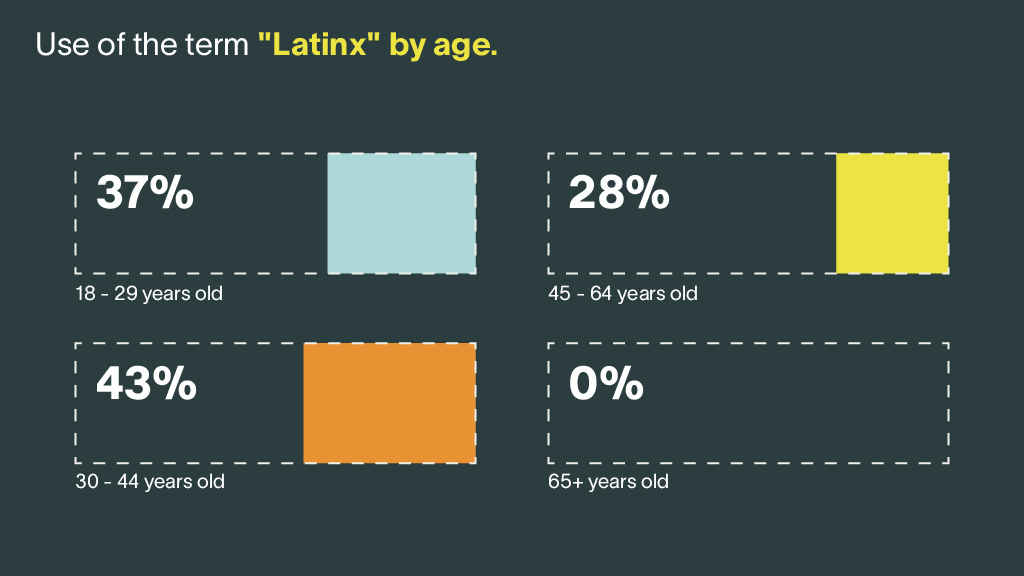
At a high-level, this data seems to convey that Asian, American Indian/Alaska Native, Black, Latino, and Native Hawaiian/Pacific Islanders often prefer to identify with the individual cultural, ethnic or racial group that their families identify with, instead of broader terms that may not be able to reflect depth or nuance.
While this data can help us see some trends, what it reinforces is there is no one size fits all approach. It is important to continuously validate terminology and ensure word choice reflects your audience based on their culture, experience and preferences.
YouTube and Video Are Key
Many factors influence the media channels where an individual spends their time and attention. To be as targeted as possible in campaign planning, it’s important to understand where your audiences already are so you can most effectively reach them.
Our respondents, similar to the general public, are digitally engaged on multiple social media platforms. We found that YouTube is key to engaging communities of color across the Pacific Northwest with a surprisingly high 96% of all respondents spending time on the platform. It was ranked the top social channel across all cultures and ages we surveyed. More than 60% under age 64 use it every day.
Within these results, those most likely to use YouTube daily included Native Hawaiian/Pacific Islander (77%), American Indian/Alaska Native (66%) and Asian (65%) communities. Furthermore, over half (64%) of our Spanish speaking respondents indicated they use YouTube daily.
From a campaign planning perspective, these findings demonstrate the value of potentially adding YouTube to your marketing channel mix, depending on your goals, and reinforce the importance of video content as a medium for resonant communication.
Customization is key to a successful campaign channel strategy. To best reach Asian, American Indian/Alaska Native, Black, Latino, and Native Hawaiian/Pacific Islanders in the Pacific Northwest via social media, here are a few additional findings to help guide your strategy:
- Facebook was the top social platform specifically for news and information (82% use). It was also the most popular platform for those 30-44 (88% use) and 45-64 (90% use).
- TikTok (83% use) and Instagram (90% use) are where to reach younger communities of color (18-29) in the Puget Sound. Among this younger audience, social media influencers were ranked higher than friends + family as a trusted source.
- Black and Latino audiences were also most likely to use Instagram and TikTok.
- Over half (64%) of Spanish speaking respondents indicated they use Facebook daily and 77% use WhatsApp.
If you are looking to segment your audiences more specifically, we created the following guide of platform use by community, daily use and age to help guide your outreach strategies. Click the arrow on the graphic below to toggle through each table.
Key Takeaways
Effectively engaging communities of color in the Puget Sound requires a clear understanding of your audiences, their values and where they are spending their time. Here are three tips to keep in mind as you design your next strategic communications plan to reach multicultural audiences.
- Take the time to get to know your audience. Communities of color in the region highly value their sense of community, love of nature and their role in their family as part of their identity. Leaning into these values and reflecting them throughout your messaging and creative can help resonate with your multicultural audiences. Furthermore, identifying the additional languages your audiences speak and tailoring your content so it’s available in multiple languages through transcreation can also ensure cultural resonance.
- Develop an integrated approach to channel strategy. Meet your audiences where they are already spending their time. Similarly to the general public, communities of color are highly engaged online and predominantly consuming video content. It’s important to ensure your communications content is optimized and designed for all channels, and reflects their values. Additionally, local media is still an important third-party validator for audiences who are looking for news and information they can trust. That means PR plays an important role in engaging with the community in an integrated campaign.
- Plan for nuances within your multicultural audiences. When communicating with diverse audiences, we also must consider intersectionality and the convergence of multiple personal characteristics that influence how someone will receive and connect with information. For example, throughout our research, we see how impactful age is on both how individuals define and identify themselves, as well as the top media and social channels where they spend their time. As you design your strategy, go beyond racial/ethnic considerations and determine if there are intersecting identities you need to account for as well.
Webinar
On July 11, 2024, DHM Research and Quinn Thomas presented this report in a virtual webinar.
Methodology
From April 2 – April 16, 2024, DHM Research conducted a survey of 600 BIPOC adults in the Puget Sound area. The purpose of the survey was to generate Insights about how to thoughtfully engage Communities of Color across the Puget Sound in ways that align with their preferences and are based in their values.
Respondents were members of professionally maintained online panels and were invited to the survey via text and email. A variety of quality control measures were employed, including questionnaire pre-testing and validation. A combination of quotas and weighting by age, gender, education, income, race, ethnicity, and county within the Puget Sound. These quotas were used to match the demographic makeup of Communities of Color in the Puget Sound.
About DHM Research
DHM Research has been providing opinion research and consultation throughout the Pacific Northwest and other regions of the United States for over 45 years. The firm is nonpartisan and independent and specializes in research projects to support public policy making.
About Quinn Thomas
Quinn Thomas is an award-winning marketing communications and brand strategy agency founded in 2009. The agency is committed to thorough, audience-focused research and using it as the foundation for approaching every new communications challenge. The agency has offices in Seattle and Portland and has extensive experience in higher education, healthcare, energy and real estate.
About Creativo Consulting
Creativo Consulting is a cultural consulting firm guided by multicultural and multilingual veterans; each with decades of professional experience in the fields of cultural consulting, language services and technology. The firm’s core focus is on deeply resonant messaging that speaks to specific cultural groups across all media in any language.

